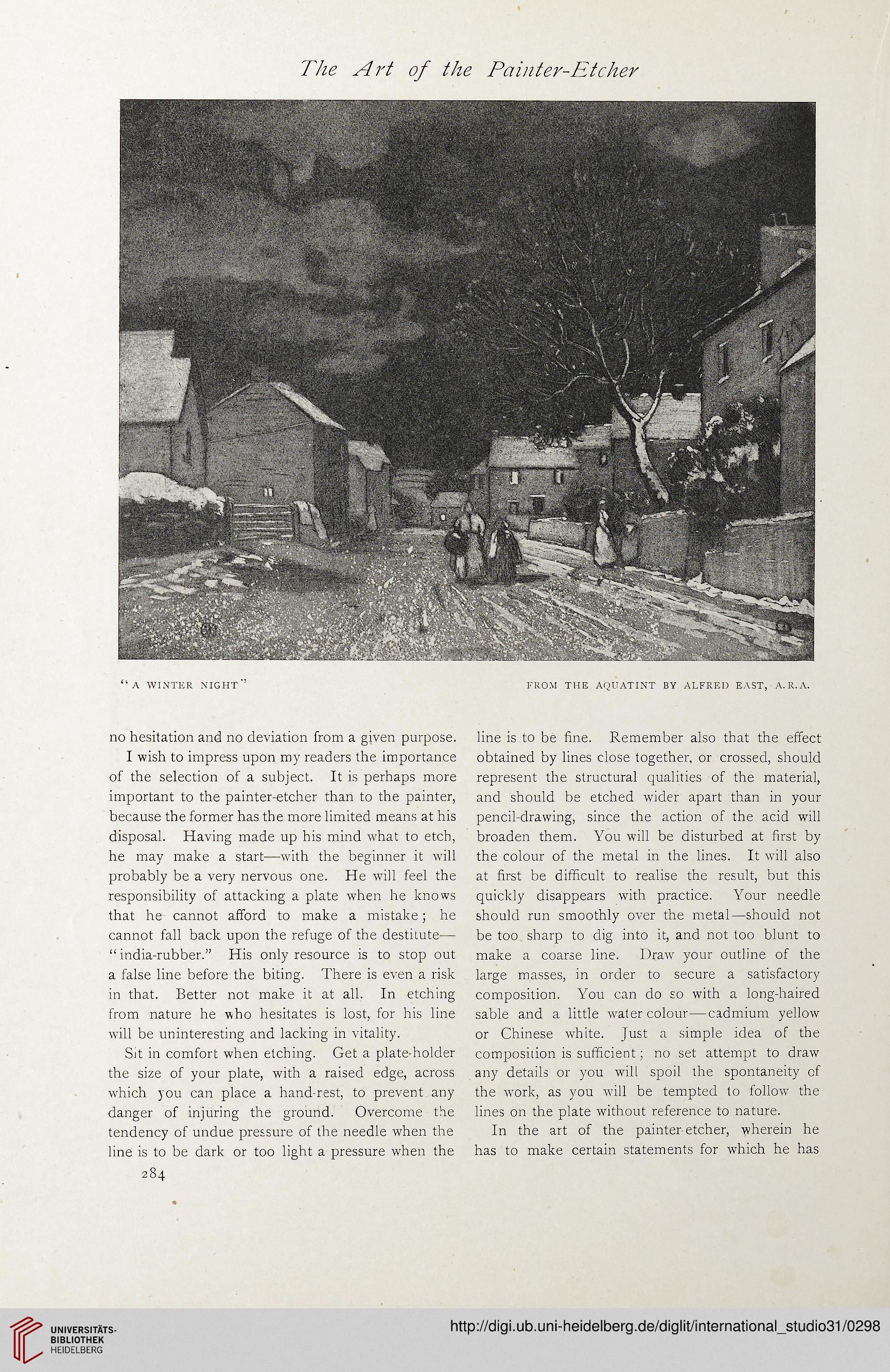The Art of the Painter-Etcher
“a winter night’’
FROM THE AQUATINT BY ALFRED EAST, A. R. A.
no hesitation and no deviation from a given purpose.
I wish to impress upon my readers the importance
of the selection of a subject. It is perhaps more
important to the painter-etcher than to the painter,
because the former has the more limited means at his
disposal. Having made up his mind what to etch,
he may make a start—with the beginner it will
probably be a very nervous one. He will feel the
responsibility of attacking a plate when he knows
that he cannot afford to make a mistake; he
cannot fall back upon the refuge of the destitute—
“india-rubber.” His only resource is to stop out
a false line before the biting. There is even a risk
in that. Better not make it at all. In etching
from nature he who hesitates is lost, for his line
will be uninteresting and lacking in vitality.
Sit in comfort when etching. Get a plate-holder
the size of your plate, writh a raised edge, across
which you can place a hand-rest, to prevent any
danger of injuring the ground. Overcome the
tendency of undue pressure of the needle when the
line is to be dark or too light a pressure when the
284
line is to be fine. Remember also that the effect
obtained by lines close together, or crossed, should
represent the structural qualities of the material,
and should be etched wider apart than in your
pencil-drawing, since the action of the acid will
broaden them. You will be disturbed at first by
the colour of the metal in the lines. It will also
at first be difficult to realise the result, but this
quickly disappears with practice. Your needle
should run smoothly over the metal—should not
be too sharp to dig into it, and not too blunt to
make a coarse line. Draw your outline of the
large masses, in order to secure a satisfactory
composition. You can do so with a long-haired
sable and a little wrater colour—cadmium yellow
or Chinese white. Just a simple idea of the
composiuon is sufficient; no set attempt to draw
any details or you will spoil the spontaneity of
the work, as you will be tempted to followr the
lines on the plate without reference to nature.
In the art of the painter-etcher, wherein he
has to make certain statements for which he has
“a winter night’’
FROM THE AQUATINT BY ALFRED EAST, A. R. A.
no hesitation and no deviation from a given purpose.
I wish to impress upon my readers the importance
of the selection of a subject. It is perhaps more
important to the painter-etcher than to the painter,
because the former has the more limited means at his
disposal. Having made up his mind what to etch,
he may make a start—with the beginner it will
probably be a very nervous one. He will feel the
responsibility of attacking a plate when he knows
that he cannot afford to make a mistake; he
cannot fall back upon the refuge of the destitute—
“india-rubber.” His only resource is to stop out
a false line before the biting. There is even a risk
in that. Better not make it at all. In etching
from nature he who hesitates is lost, for his line
will be uninteresting and lacking in vitality.
Sit in comfort when etching. Get a plate-holder
the size of your plate, writh a raised edge, across
which you can place a hand-rest, to prevent any
danger of injuring the ground. Overcome the
tendency of undue pressure of the needle when the
line is to be dark or too light a pressure when the
284
line is to be fine. Remember also that the effect
obtained by lines close together, or crossed, should
represent the structural qualities of the material,
and should be etched wider apart than in your
pencil-drawing, since the action of the acid will
broaden them. You will be disturbed at first by
the colour of the metal in the lines. It will also
at first be difficult to realise the result, but this
quickly disappears with practice. Your needle
should run smoothly over the metal—should not
be too sharp to dig into it, and not too blunt to
make a coarse line. Draw your outline of the
large masses, in order to secure a satisfactory
composition. You can do so with a long-haired
sable and a little wrater colour—cadmium yellow
or Chinese white. Just a simple idea of the
composiuon is sufficient; no set attempt to draw
any details or you will spoil the spontaneity of
the work, as you will be tempted to followr the
lines on the plate without reference to nature.
In the art of the painter-etcher, wherein he
has to make certain statements for which he has




